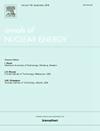印度尼西亚Triga 2000反应堆核心部件的放射性核素计算:重点关注氚(H3)及其对退役的影响
IF 1.9
3区 工程技术
Q1 NUCLEAR SCIENCE & TECHNOLOGY
引用次数: 0
摘要
本文提供了在TRIGA 2000万隆反应堆核心部件内产生的放射性核素的估计。这项研究对于修订退役计划和预测放射性废物的数量和活动水平至关重要。这项研究主要集中在反应堆堆芯内的氚放射性核素。MCNP 6.1用于确定反应堆运行期间的中子通量,而ORIGEN2.1用于识别由于中子活化而产生的放射性核素。计算的时间跨度为19年,以2020年为基准年。建模的重点是反应堆池水组分的计算。研究结果表明,从重量上看,氚并不是所有成分中的主导同位素,其质量百分比几乎为零,但在放射性核素中,氚表现出高水平的活化和最高水平的放射性,第一年从12%到13%不等,由于放射性衰变,19年后逐渐下降。到第19年,人们注意到放射性显著减少。核设施的退役需要综合考虑成本、风险、潜在环境影响、人类安全、法规遵从性和所选择的技术策略等因素。本文章由计算机程序翻译,如有差异,请以英文原文为准。
Radionuclide calculation in the core components of Indonesia’s Triga 2000 reactor: Focus on tritium (H3) and its effect on decommissioning
This paper provides estimations of the radionuclides created within the core components of the TRIGA 2000 Bandung reactor. This research is essential for the revision of decommissioning programs and forecasting the quantity and activity levels of radioactive wastes. This study predominantly focused on the tritium radionuclide within the reactor core. MCNP 6.1 was employed to determine the neutron flux during the reactor operation, while ORIGEN2.1 was utilized to identify the radionuclides produced as a result of neutron activation. The calculations extend across a nineteen-year, with 2020 as the base year. The modelling is focused on the calculation of the water components of the reactor pool. The findings suggest that Tritium is not the dominant isotope among all components from weight, with mass percentages almost zero but among the radionuclides, Tritium demonstrates a high level of activation and the highest level of radioactivity, ranging from 12% to 13% in the first year and declining over nineteen years as a result of radioactive decay. By the nineteenth year, a significant decrease in radioactivity was noted. Decommissioning nuclear facilities necessitates a comprehensive approach that considers factors such as cost, risk, potential environmental impacts, human safety, regulatory compliance, and the selected technical strategy.
求助全文
通过发布文献求助,成功后即可免费获取论文全文。
去求助
来源期刊

Annals of Nuclear Energy
工程技术-核科学技术
CiteScore
4.30
自引率
21.10%
发文量
632
审稿时长
7.3 months
期刊介绍:
Annals of Nuclear Energy provides an international medium for the communication of original research, ideas and developments in all areas of the field of nuclear energy science and technology. Its scope embraces nuclear fuel reserves, fuel cycles and cost, materials, processing, system and component technology (fission only), design and optimization, direct conversion of nuclear energy sources, environmental control, reactor physics, heat transfer and fluid dynamics, structural analysis, fuel management, future developments, nuclear fuel and safety, nuclear aerosol, neutron physics, computer technology (both software and hardware), risk assessment, radioactive waste disposal and reactor thermal hydraulics. Papers submitted to Annals need to demonstrate a clear link to nuclear power generation/nuclear engineering. Papers which deal with pure nuclear physics, pure health physics, imaging, or attenuation and shielding properties of concretes and various geological materials are not within the scope of the journal. Also, papers that deal with policy or economics are not within the scope of the journal.
 求助内容:
求助内容: 应助结果提醒方式:
应助结果提醒方式:


